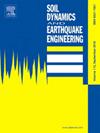Study on prediction model of cumulative plastic strain of Pisha sandstone based on grey systems theory
IF 4.2
2区 工程技术
Q1 ENGINEERING, GEOLOGICAL
引用次数: 0
Abstract
Pisha sandstone (PS) rapidly collapses in water and its performance deteriorates seriously, and its special engineering properties have always been the focus of researchers. In areas where fillers are scarce, it is of great significance to use PS as roadbed fillers to slow down soil erosion and green environmental protection. However, the long-term deformation characteristics after construction need further study. To reveal the long-term dynamic characteristics of Pisha sandstone fillers (PSF) under vehicle load, this study conducted the cyclic loading test of PSF by using the GDS triaxial test system. The deformation characteristics of PSF under different cyclic stress ratios (ζ) and load frequencies (f) were studied. The grey correlation analysis method was used to obtain the correlation degree of each influencing factor to the cumulative plastic strain (CPS) of the PSF. Finally, the grey GM (1,1) model is used to predict the CPS data of PSF. Based on this, the classical semi-logarithmic strain model is modified, and the CPS prediction model of PSF is established. The results reveal that the ζ and f will promote the development of axial deformation of PSF. The axial elastic deformation (εe) and CPS of PSF increase with the increase of ζ, and the ζ has a great influence on the CPS. The influence of f on εe is more significant at high stress levels and less significant at low stress levels. The influence of f on CPS is opposite to that of εe, that is, the influence of high stress level is small, and the influence of low stress level is large. According to the degree of correlation, the factors are sorted according to the degree of influence: static strength (σf) > confining pressure (σ3) > dynamic static stress ratio (η) > load frequency (f) > cyclic stress ratio (ζ). The GM (1,1) model has high accuracy and reliability for the quantitative description and prediction of the CPS of PSF. At the same time, according to the test and GM (1,1) model prediction results, the CPS prediction model of PSF was established. The research can provide insights and references for the establishment of cumulative deformation and prediction model of PSF under cyclic loading.
求助全文
约1分钟内获得全文
求助全文
来源期刊

Soil Dynamics and Earthquake Engineering
工程技术-地球科学综合
CiteScore
7.50
自引率
15.00%
发文量
446
审稿时长
8 months
期刊介绍:
The journal aims to encourage and enhance the role of mechanics and other disciplines as they relate to earthquake engineering by providing opportunities for the publication of the work of applied mathematicians, engineers and other applied scientists involved in solving problems closely related to the field of earthquake engineering and geotechnical earthquake engineering.
Emphasis is placed on new concepts and techniques, but case histories will also be published if they enhance the presentation and understanding of new technical concepts.
 求助内容:
求助内容: 应助结果提醒方式:
应助结果提醒方式:


